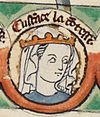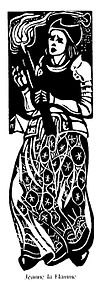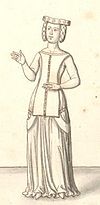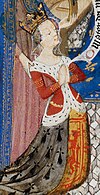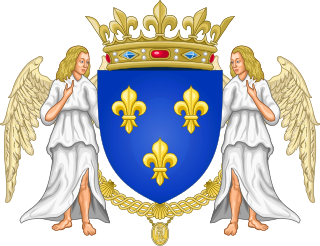
The House of Valois was a cadet branch of the Capetian dynasty. They succeeded the House of Capet to the French throne, and were the royal house of France from 1328 to 1589. Junior members of the family founded cadet branches in Orléans, Anjou, Burgundy, and Alençon.

Philip II the Bold was Duke of Burgundy and jure uxoris Count of Flanders, Artois and Burgundy. He was the fourth and youngest son of King John II of France and Bonne of Luxembourg.
An appanage, or apanage, is the grant of an estate, title, office or other thing of value to a younger child of a sovereign, who would otherwise have no inheritance under the system of primogeniture. It was common in much of Europe.

The Duchy of Brittany was a medieval feudal state that existed between approximately 939 and 1547. Its territory covered the northwestern peninsula of Europe, bordered by the Atlantic Ocean to the west, and the English Channel to the north. It was also less definitively bordered by the Loire River to the south, and Normandy, and other French provinces, to the east. The Duchy was established after the expulsion of Viking armies from the region around 939. The Duchy, in the 10th and 11th centuries, was politically unstable, with the dukes holding only limited power outside their own personal lands. The Duchy had mixed relationships with the neighbouring Duchy of Normandy, sometimes allying itself with Normandy, and at other times, such as the Breton-Norman War, entering into open conflict.

Arthur II, of the House of Dreux, was Duke of Brittany from 1305 to his death. He was the first son of John II and Beatrice, daughter of Henry III of England and Eleanor of Provence.

John III the Good was Duke of Brittany, from 1312 to his death and 5th Earl of Richmond from 1334 to his death. He was the son of Duke Arthur II of Brittany and Mary of Limoges, his first wife. John was strongly opposed to his father's second marriage to Yolande of Dreux, Queen of Scotland and attempted to contest its legality.

Arthur III, more commonly known as Arthur de Richemont, was briefly Duke of Brittany from 1457 until his death. He is noted primarily, however, for his role as a leading military commander during the Hundred Years' War. Although Richemont briefly sided with the English once, he otherwise remained firmly committed to the House of Valois. He fought alongside Joan of Arc, and was appointed Constable of France. His military and administrative reforms in the French state were an important factor in assuring the final defeat of the English in the Hundred Years' War.
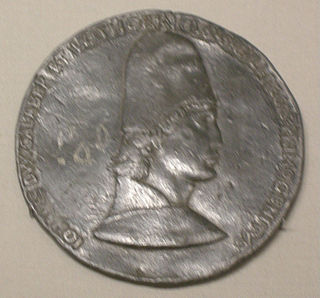
John II of Anjou was Duke of Lorraine from 1453 to his death. He was the son of René of Anjou and Isabella, Duchess of Lorraine. He was married to Marie de Bourbon, daughter of Charles I, Duke of Bourbon.

Duke of Bourbon is a title in the peerage of France. It was created in the first half of the 14th century for the eldest son of Robert of France, Count of Clermont and Beatrice of Burgundy, heiress of the lordship of Bourbon. In 1416, with the death of John of Valois, the Dukes of Bourbon were simultaneously Dukes of Auvergne.

The now-extinct title of Earl of Richmond was created many times in the Peerage of England. The earldom of Richmond was initially held by various Breton nobles associated with the Ducal crown of Brittany; sometimes the holder was the Breton Duke himself, including one member of the cadet branch of the French Capetian dynasty. The historical ties between the Ducal crown of Brittany and this English Earldom were maintained ceremonially by the Breton dukes even after England ceased to recognize the Breton Dukes as Earls of England and those dukes rendered homage to the King of France, rather than the English crown. It was then held either by members of the English royal families of Plantagenet and Tudor, or English nobles closely associated with the English crown. It was eventually merged into the English crown during the reign of Henry VII and has been recreated as a Dukedom.
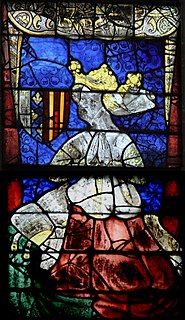
Yolande of Aragon was Duchess of Anjou and Countess of Provence by marriage, who acted as regent of Provence during the minority of her son. She was a daughter of John I of Aragon and his wife Yolande of Bar. Yolande played a crucial role in the struggles between France and England, influencing events such as the financing of Joan of Arc's army in 1429 that helped tip the balance in favour of the French. She was also known as Yolanda de Aragón and Violant d'Aragó. Tradition holds that she commissioned the famous Rohan Hours.

The House of Capet or the Direct Capetians, also called the House of France, or simply the Capets, ruled the Kingdom of France from 987 to 1328. It was the most senior line of the Capetian dynasty – itself a derivative dynasty from the Robertians. Historians in the 19th century came to apply the name "Capetian" to both the ruling house of France and to the wider-spread male-line descendants of Hugh Capet. Contemporaries did not use the name "Capetian". The Capets were sometimes called "the third race of kings". The name "Capet" derives from the nickname given to Hugh, the first Capetian king.

In the 11th and 12th centuries the Countship of Penthièvre in Brittany belonged to a branch of the sovereign House of Brittany. It initially belonged to the House of Rennes. Alan III, Duke of Brittany, gave it to his brother Eudes in 1035, and his descendants formed a cadet branch of the ducal house.

The House of Montfort was a Breton-French noble family, which reigned in the Duchy of Brittany from 1365 to 1514. It was a cadet branch of the House of Dreux; it was thus ultimately part of the Capetian dynasty. It should not be confused with the older House of Montfort which ruled as Counts of Montfort-l'Amaury.

Originally, the Duchy of Chartres was the comté de Chartres, a County. The title of comte de Chartres thus became duc de Chartres. This duchy–peerage was given by Louis XIV of France to his nephew, Philippe II d'Orléans, at his birth in 1674. Philippe II was the younger son and heir of the king's brother, Philippe de France, Duke of Orléans.
The crown lands, crown estate, royal domain or domaine royal of France were the lands, fiefs and rights directly possessed by the kings of France. While the term eventually came to refer to a territorial unit, the royal domain originally referred to the network of "castles, villages and estates, forests, towns, religious houses and bishoprics, and the rights of justice, tolls and taxes" effectively held by the king or under his domination. In terms of territory, before the reign of Henry IV, the domaine royal did not encompass the entirety of the territory of the kingdom of France and for much of the Middle Ages significant portions of the kingdom were the direct possessions of other feudal lords.

The union of Brittany and France was a critical step in the formation of modern-day France. Brittany had been a semi-independent component of the Kingdom of France since Clovis I was given authority over the Gallo-Roman domain during the 5th century. It was first recorded as a "duchy" during the rule of Nominoe in 846. Over the centuries, the fealty demonstrated by the Duchy of Brittany toward the French king depended significantly on the individuals holding the two titles, as well as the involvement of the English monarchy at that particular time. The reign of Francis II, Duke of Brittany, was at an especially crucial time, as the nobles struggled to maintain their autonomy against the increasing central authority desired by Louis XI of France. As a result of several wars, treaties, and papal decisions, Brittany was united with France through the eventual marriage of Louis XI's son Charles VIII to the heiress of Brittany, Anne in 1491. However, because of the different systems of inheritance between the two realms, the crown and the duchy were not held by the same hereditary claimant until the reign of Henry II, beginning 1547.

The Duchess of Brabant refers to a woman married to the Duke of Brabant or a Duchess of Brabant suo jure. But this was only as of 1840 when it was revived as an honorific title for the Crown Prince of the newly created Kingdom of Belgium. There have been only three royal duchesses.


